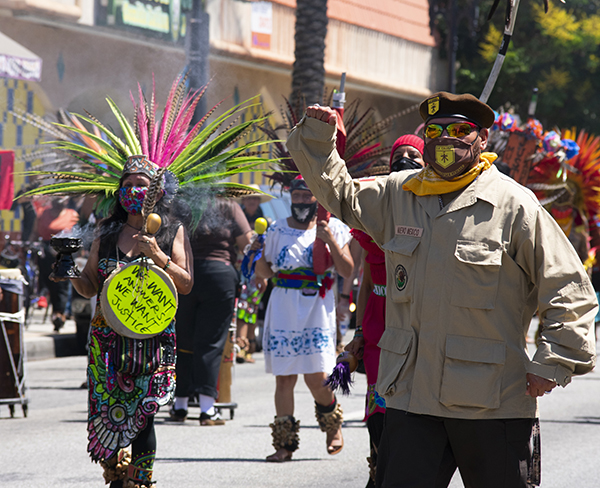By Jose Ivan Cazares
Contributing Writer
EAST LOS ANGELES — Lowriders, Aztec dancers and hundreds of revelers paraded down Whittier Boulevard in cars and on foot Aug. 29 to commemorate the 50th anniversary of the Chicano Moratorium.
The caravan traveled from Pico Rivera to Ruben Salazar Park in East Los Angeles to honor those who participated in the largest anti-Vietnam War demonstration of Chicanos in the United States.
Many Latinos identified as white historically in order to assimilate to American life. Starting in the early 1900s, however, many Mexican Americans started embracing the term Chicano as a way to embrace their Indigenous roots and affirm themselves as non-white, while fighting for the the political rights of their community.
The 50th anniversary march followed the same route as the original protest on Aug. 29, 1970, when more than 20,000 people turned out to protest the number of Latinos being drafted into and dying in the Vietnam War. The peaceful protest turned violent when police, who said they had gotten reports that a nearby liquor store was being robbed, used gas canisters and batons to disperse the crowd.
The violence resulted in the death of four people, including Los Angeles Times journalist Ruben Salazar, who died instantly after a sheriff’s deputy fired a tear gas canister that hit him in the head. A key leader in the Chicano movement and one of the first journalists to bring mainstream media coverage to it, Salazar galvanized other Chicanos to get politically involved in their communities. Laguna Park was later renamed in his honor.
The atmosphere at Salazar Park was festive, with drummers following lively Aztec dancers, low riders bouncing down the street, children cruising on bicycles and street vendors serving up hotdogs and traditional Mexican snacks. Anger and frustration were also palpable, when speakers took to the stage at Salazar Park with calls to “defund the police.” They also emphasized voting in November and getting involved in civil rights activism.
Black and Brown solidarity was also a prominent theme, with Justice X, an alliance of black and brown defense attorneys, invited to speak at the rally.
“We’re dealing with issues of homelessness, we’re dealing with issues of racism and issues of imprisonment,” said Stephen King, a lawyer and cofounder of Justice X. King and another Justice X attorney, Humberto Guizar, filed a class action lawsuit against the Los Angeles Police Department for systematically misclassifying minorities as gang members or gang-affiliated in their case reports. Both spoke at the rally in favor of police reform and showing solidarity with other minority groups to achieve needed reforms.
Members of the Brown Berets, a Chicano civil rights group, helped redirect traffic for the parade of demonstrators in the most congested parts of East L.A. and helped secure the stage at Salazar Park. The group was formed in 1968 after walkouts by East L.A. students protesting unequal conditions in the Los Angeles Unified School District. Current members said the rights they were fighting for back then are still out of reach today.
“I joined the Brown Berets because I’ve seen my family and friends face a lot of the same injustices people fought for in 1970,” said Xochil Gonzales, a spokesperson for the Brown Berets. She’s been a member for two years.
“My parents came here from Mexico to work. My father was a migrant worker in the fields for over 20 years, and my mother was a housekeeper. It’s for people like them and my six children that I’m out trying to create change.”
The parade received some backlash from a group of bikers attending a memorial for a fallen Marine from Montebello, Lance Cpl. Marco Barranco. The bikers started shouting insults at parade participants holding Black Lives Matter signs and police escorting the marchers had to reroute the parade around them to prevent a confrontation.












